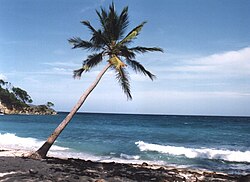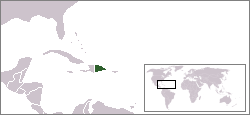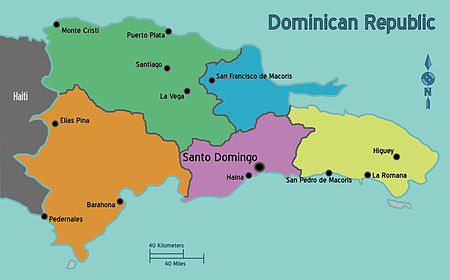| Dominican Republic | |
 | |
Location  | |
Coat of arms and flag  | |
| Capital | Santo Domingo |
|---|---|
| Government | presidential republic |
| Currency | Dominican Peso (PDO) |
| Surface | 48,671 km² |
| Inhabitants | 8.830.000 |
| Tongue | Spanish |
| Religion | Catholic 95% |
| Electricity | 110V / 60Hz (American plug) |
| Prefix | 1809, 1829, 1849 |
| TLD | .do |
| Time zone | UTC-4 |
| Website | Tourist Board |
Dominican Republic is a state of the Caribbean whose territory occupies the eastern part of the island of Hispaniola.
To know
When to go
The climate is tropical maritime, with small seasonal variations in temperature. The average daytime temperature varies from around 25 ° in January to 30 ° in July in the city of Santo DomingoThe period from June to October is the rainy season and it is also the period in which hurricanes appear which, however, in the Dominican Republic are less destructive than elsewhere. In any case, it is good to inquire about the weather conditions in the country if the departure is scheduled for this period.
Background

The original name of the island of Hispaniola was Quisqueya which in the Taino language means "Mother of all lands". The Tainos were the original inhabitants of the island estimated at about 250,000 individuals at the time of the first landing of Christopher Columbus (December 5, 1492). They lived by hunting and fishing and were also devoted to agriculture and the cultivation of tobacco. It was from the Taino that Europeans took on the harmful habit of smoking the leaves. Subsequently, the oppression of the conquistadors, the forced labor to which they were obliged and the diseases imported by Europeans decimated the original population within fifty years.
The island of Hispaniola it became the starting point for the expansion into the Caribbean and the rest of the American continent by the Spanish conquistadors.
In 1697, the Spain recognized the domain of the France in the western part of the island, which in 1804 it became Haiti. The rest of the island, previously known as Santo Domingo, tried to gain its independence in 1821, but was conquered and ruled by the Haitians for 22 years; achieved independence, with the name of the Dominican Republic, in 1844, thanks to a trio of liberators: Juan Pablo Duarte, Ramon Matias Mella and Francisco del Rosario Sanchez. In 1916 the United States occupied the island. The withdrawal of American troops in 1924 was followed by the dictatorship of Rafael Trujllo who was assassinated in 1961. After his death, democracy was reintroduced to the country.
Territories and tourist destinations
The main attraction of the country is its seaside resorts with beaches with crystal clear waters.

Southern coast
Santo Domingo - The capital of the country and of the ... merengue.
East of Santo Domingo
On the stretch of coast east of the capital, the most interesting centers are:
- Boca Chica (25 km) - A few minutes from Las Americas International Airport, Boca Chica is a seaside resort on a large bay protected by a coral reef. Given its proximity to the capital, Boca Chica it is very busy and has an intense nightlife
- Juan Dolio (50 km) - A locality near the enchanting beaches of Playa Caribe, Playa Guayacanes and Playa Juan Dolio.
- San Pedro de Macoris - Provincial capital built in the early nineteenth century and became very prosperous thanks to the sugar trade, so much so that it earned the nickname "Sultana of the East". It still has many mansions that were residences of wealthy landowners in colonial times.
- La Romana (140 km) - Third largest city in the country by population (about 250,000 inhabitants) La Romana it is a large agricultural center among extensive sugar cane plantations. Its tourist importance is to be found in the surrounding beaches. Just across the Dulce River is Casa de Campo, a tourist complex that also has a private airport. In front of this stretch of coast lies the Isla Catalina, surrounded by coral reefs and a destination for excursions from La Romana
- Altos de Chavon - A 1970s Mediterranean-style artists' village set up by the Italian Roberto Coppa who took care of the sets for some films by Fellini and De Laurentis. The films "Apocalypse Now" and "King Kong" were shot there. There is also an amphitheater where Luciano Pavarotti and Celia Cruz, the famous Salsa singer, performed. The construction of the village was financed by Charles Blühdorn (1926-1983), an American industrialist of Austrian descent who was, among other things, president of Paramount Pictures. His daughter Dominique takes care of the administration of the village. There is only one hotel but on the other hand there are notable craft shops, (goldsmith's, ceramics and fabrics). The village is located just a few minutes from the center of La Romana
- Bayahibe - 20 km from La Romana, Bayahibe it is a fishing port and a first-rate seaside resort with large hotel complexes and much appreciated by those who practice scuba diving.
- Isla Saona - At the far end of the east coast, Isla Saona is part of the Este National Park
- Higüey - Large center of the hinterland Higüey it is on the da La Romana to Bavaro is Punta Cana, crossed by buses.
West of Santo Domingo
- San Cristobal —
- Bani - One hour from the capital, base for excursions to the nearby salt pans
- Barahona - With quiet beaches and a base for excursions to the Sierra de Baharuco with peaks over 2,000m
- Palenque —
- Enriquillo Lake - A salt water lake in the center of a nature reserve
- Jaragua National Park - Including also the Blessed Island
Northern coast
On the north coast the most interesting places are:
- Monte Christi —
- Sosua —
- Puerto Plata - The largest inhabited center on the Atlantic side.
- Cabarete - Annual meeting of surf enthusiasts.
- Rio San Juan —
- Cabrera - our
- Samaná - A peninsula that forms a bay sheltered from the trade winds. There are many beaches including Las Terrenas, Playa Galeras and Cayo Levantado.
- Playa Bavaro is Punta Cana - Two tourist centers at the eastern end of Hispaniola. Both locations are equipped with luxury hotels that work with the major tour operators in the world so they are not suitable for individual tourists.
The interior
- Santiago de los Caballeros - Second city in the country inland along the road leading to the Atlantic coast.
How to get
By plane
Many charter flights from Italy that you will find in the agency or by sifting through a suitable search engine such as zingarate.com. We mention those of Blue-panorama.
The main international airport is that of Las Americas 20 km from the capital.
Air Europa and Iberia operate scheduled flights from Madrid
At the airport of Punta Cana other scheduled and charter flights arrive including Air Berlin
Other airports are those of La Romana and Puerto Plata.
The landing fee is 10 USD, to be paid exclusively in American currency (there is an exchange office at the airport, before going through customs).
Pay attention to the boarding tax: it depends on the length of your stay, it is important to read the coupon delivered by customs upon arrival in the country.
How to get around
By car
Numerous car rental agencies, including international companies, are present everywhere. The rental cost is around € 50 - € 60 per day for a medium-sized car.
Although all the main roads are paved, the carriageways are not always manicured, and it is quite easy to run into sudden potholes.
By bus
To move around the country, intercity buses are used. These are always air-conditioned and offer a comfortable ride.
What see
What to do
Currency and purchases
The Dominican Peso (DOP) is the national currency. The banknotes are in denominations of 10, 20, 50, 100, 200, 500, 1,000 and 2,000 Pesos, while the coins circulate in pieces of 1, 5, 10 and 25 Pesos.
Below are the links to know the current exchange rate with the main world currencies:
| (EN) With Google Finance: | AUDCADCHFEURGBPHKDJPYUSD |
| With Yahoo! Finance: | AUDCADCHFEURGBPHKDJPYUSD |
| (EN) With XE.com: | AUDCADCHFEURGBPHKDJPYUSD |
| (EN) With OANDA.com: | AUDCADCHFEURGBPHKDJPYUSD |
Amber is a local product. It will be offered to you on the street everywhere in the tourist spots but be sure that it is plastic. In Puerto Plata there is a museum dedicated to amber with an adjoining shop equipped with a spectrometer that shows how real amber changes color.
Other souvenirs are ceramic products, cigars and stuffed baskets
At the table
- Dominican Bandera - The national dish
- Sancocho or Salcocho prieto
- Chicarron de pollo
- Locrio de cerdo
- Pescado with coco
- Platano - Fried Bananas
Drinks


- Beer - Among the local beers the most popular brands are "Presidente" and "Quisqueya".
- Rum - Rum blanco is the driest and cheapest. It is generally mixed with fruit juices (refrescos). Some local brands of rum are: Carta Vieja, Barcelo, Brugal, Bermudez.
- Agua de Coco - Coconut milk served cold
Tourist infrastructure
Events and parties
Safety
It is advisable to observe the necessary precautionary measures, in particular if you go around unaccompanied in the capital: there are quite frequent cases of thefts and muggings against tourists. If you are stopped in your car at the traffic lights, it is advisable to close the doors and also the windows.
Health situation
In the rainforest area, the main risk is malaria, caused by the Anopheles mosquito. Outside of wooded areas, the risk is non-existent. If necessary consult a doctor before leaving. Some mosquitoes, however, could cause fever; it is strongly recommended to use a mosquito repellent.
Local foods are generally safe, and present no danger. Foreigners, however, should not drink tap water but only bottled water.
Respect the customs
How to keep in touch
Telephony
- Mobile phones are very popular, amounting to about five million, one for every two inhabitants. There are two mobile phone companies:
- Yellow Pages: Yellow Pages of the Caribbean, First Yellow.
Internet
The wi-fi spots were almost non-existent until October 2007, the month in which the new WiMax technology was introduced by the company "OneMax".
Keep informed
- Listin Diary - The oldest newspaper.
- Hoy
- El Nacional
Other projects
 Wikipedia contains an entry concerning Dominican Republic
Wikipedia contains an entry concerning Dominican Republic Commons contains images or other files on Dominican Republic
Commons contains images or other files on Dominican Republic Wikiquote contains quotes from or about Dominican Republic
Wikiquote contains quotes from or about Dominican Republic Wikinews contains current news on Dominican Republic
Wikinews contains current news on Dominican Republic
![]() Antigua and Barbuda ·
Antigua and Barbuda · ![]() Bahamas ·
Bahamas · ![]() Barbados ·
Barbados · ![]() Belize ·
Belize · ![]() Canada ·
Canada · ![]() Costa Rica ·
Costa Rica · ![]() Cuba ·
Cuba · ![]() Dominica ·
Dominica · ![]() El Salvador ·
El Salvador · ![]() Jamaica ·
Jamaica · ![]() Grenada ·
Grenada · ![]() Guatemala ·
Guatemala · ![]() Haiti ·
Haiti · ![]() Honduras ·
Honduras · ![]() Mexico ·
Mexico · ![]() Nicaragua ·
Nicaragua · ![]() Panama[1] ·
Panama[1] · ![]() Dominican Republic ·
Dominican Republic · ![]() Saint Kitts and Nevis ·
Saint Kitts and Nevis · ![]() Saint Lucia ·
Saint Lucia · ![]() Saint Vincent and the Grenadines ·
Saint Vincent and the Grenadines · ![]() United States of America ·
United States of America · ![]() Trinidad and Tobago[2]
Trinidad and Tobago[2]
Addictions French: ![]() Clipperton ·
Clipperton · ![]() Guadeloupe ·
Guadeloupe · ![]() Martinique ·
Martinique · ![]() Saint-Barthélemy ·
Saint-Barthélemy · ![]() Saint-Martin ·
Saint-Martin · ![]() Saint-Pierre and Miquelon
Saint-Pierre and Miquelon
Addictions Dutch: ![]() Aruba[2] ·
Aruba[2] · ![]() Curaçao[2] ·
Curaçao[2] · ![]() Sint Maarten ·
Sint Maarten · ![]() BES Islands (Bonaire[2], Sint Eustatius, Saba)
BES Islands (Bonaire[2], Sint Eustatius, Saba)
Addictions British: ![]() Eel ·
Eel · ![]() Bermuda ·
Bermuda · ![]() Cayman Islands ·
Cayman Islands · ![]() British Virgin Islands ·
British Virgin Islands · ![]() Montserrat ·
Montserrat · ![]() Turks and Caicos
Turks and Caicos
Addictions Americans: ![]() Puerto Rico ·
Puerto Rico · ![]() US Virgin Islands ·
US Virgin Islands · ![]() Navassa
Navassa
Marginally Central North American states: ![]() Venezuela (Aves · Archipelago of San Andrés, Providencia and Santa Catalina)
Venezuela (Aves · Archipelago of San Andrés, Providencia and Santa Catalina)
